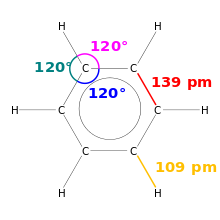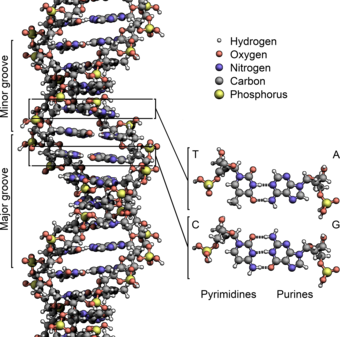User:Beland/Civilization restart
After a collapse of civilization, what knowledge would be most important to convey in order to quickly bring civilization back to its current level of development? Can that be conveyed in a short amount of written text and illustrations?
Single-Page Science[edit]
- Scientific method - The universe operates in certain predicable ways, and some can be described as mathematical laws. The only reliable way to gain information about how the universe works is through empirical testing. Form a hypothesis, design an experiment to confirm or disprove that hypothesis, and publish the result. Peer review of reports is important to ensure reliable methods were used. Over time, a consensus should emerge.
Physics[edit]

- Atomic theory - Matter is composed of huge numbers of invisibly small particles known as atoms. Each atom is composed of protons (positive electrical charge) and neutrons (neutral electrical charge) in the central nucleus, surrounded by electrons (negative electrical charge, of negligible weight) which interact between atoms to make more complicated matter. Multiple atoms bound together form a molecule.
- Heat is the random vibration of atoms, quantified by thermodynamics.
- Sound is the passage of pressure waves through a material.
- Matter can exist in the phases of solid (atoms/molecules in a fixed arrangement), liquid (atoms/molecules slipping past each other), gas (atoms/molecules bouncing around at high speed and widely spaced, filling their container), or plasma (a gas where electrons have been stripped off nuclei), depending on temperature and pressure.
- The temperature, pressure, and volume of a gas are approximately related by the ideal gas law.
- Atomic nuclei can be combined (atomic fusion) or split (atomic fission) which can require or release extremely large amounts of energy and dangerous radiation (electromagnetic and high-speed particles). Some nuclei are unstable and undergo fission spontaneously (radioactive decay).
- Fundamental interactions can affect matter and subatomic particles:
- Electric charge can be positive or negative. Like charges repel; opposite charges attract. Charge can be produced by rubbing certain materials together, such as amber, fabrics, fur, or hair, in dry air. Electricity (including lightning) is the flow of electric charge carried by moving electrons.
- Magnetic fields are generated by certain materials like iron, and the Earth has a natural one. Magnetic poles can be "north" (attracted to the Earth's northern magnetic pole, which emits a "south" field) or "south" (attracted to the Earth's southern magnetic pole, which emits a "north" field). Opposite poles attract, same poles repel.
- Electricity and magnetism are two aspects of electromagnetism. A changing magnetic field creates an electric field, and a changing electric field creates a magnetic field. The interactions are described by Maxwell's equations.
- Gravity is created by all matter and is always attractive.
- The weak interaction is responsible for radioactive decay. It can be described by electroweak theory, which describes the weak interaction and electromagnetism as different aspects of the same force.
- The strong interaction holds quarks together to form protons and neutrons, and is described by quantum chromodynamics.
- Light is a type of electromagnetic radiation or wave. Some lower frequencies are useful for heating matter (infrared, microwaves) and communications (radio waves). Some higher frequencies (X-rays) have more energy and are useful for seeing inside objects and living things, but are dangerous and can cause cancer or immediate death if over-exposed.
- The matter of everyday objects at everyday speeds are quantified by classical mechanics which assumes:
- Conservation of matter - matter is neither created nor destroyed, except when it is converted to or from energy following the rule E=mc2
- Conservation of energy - energy is neither created nor destroyed, but it can change form (chemical energy, kinetic energy, potential energy)
- At atomic scales, quantum mechanics is a better description of motion. It says: energy, momentum, angular momentum, and other quantities of a bound system are restricted to discrete values (quantization), objects have characteristics of both particles and waves (wave-particle duality), and there are limits to how accurately the value of a physical quantity can be predicted prior to its measurement, given a complete set of initial conditions (the uncertainty principle).
- The wave aspect is not apparent for everyday objects, but is important for atom-sized particles. The wave can be interpreted as the probability that the particle will be found in that location.
- Double-slit experiments can be used to show that electrons have wave-like properties.
- The particle aspect of light waves are called photons, and these explain black body radiation, the photoelectric effect, and why the energy imparted to an atom depends on the frequency but not intensity of light.
- Quantum chromodynamics, quantum electrodynamics, quantum flavordynamics
- The speed of light in a vacuum is constant no matter the velocity of the (non-rotating) observer, as are the laws of physics (special relativity). To prove this, perform the Michelson–Morley experiment. This is possible because time passes at a different rate for observers at different velocities, and it is not possible to have a velocity faster than the speed of light. The equations of general relativity describe gravity as a phenomenon of unified spacetime and it is possible to produce gravity waves which are very difficult to detect. The difference between relativistic and classical equations of motion are important for large or fast-moving objects, and noticeably affects the orbit of the planet closest to the Sun (perihelion precession of Mercury) and bending of light around large astronomical objects. General relativity has not been reconciled with quantum mechanics to produce a set of equations that accurately describe motion at all scales.
- Antimatter
Cosmology[edit]
- The Earth is approximately spherical, and its size can be calculated by observing stars from distant locations (Spherical Earth). Everyday objects are pulled toward the center of the Earth due to the gravity produced by its large mass. Gravity holds the gases we breathe (the atmosphere) around the Earth in a relatively thin layer compared to the diameter of the Earth. Beyond that is mostly vacuum.
- The Sun is a ball of plasma about 109 times the diameter of the Earth. Under the extreme pressure caused by its own gravity, it produces enormous amounts of heat and light by the atomic fusion of hydrogen ions (one proton) into helium-4 ions (two protons, two neutrons). It is over 20,000 earth diameters or 8.3 light-minutes away. The Sun produces a solar wind which can cause electromagnetic fields on Earth and lights the skies in the far north and south with mostly green aurora.
- The fixed stars are similar to the Sun, but much farther away. The closest is 4.2 light-years. They are clumped by gravity into star clusters and galaxies. The Sun is one star in the disc-like Milky Way Galaxy, which is seen edge-on from the Earth as a concentrated of band of stars in the night sky.
- Slow-moving stars that move noticeably against the fixed stars over successive nights, are actually planets which are spherical like the Earth, some smaller and rocky, some larger and made mostly of gas.
- The planets, including the Earth, move around the Sun in orbits that are approximately ellipses. Two planets are closer to the Sun than the Earth. There are also many small rocks orbiting the sun called asteroids.
- Fast-moving stars are either asteroids that have fallen into the atmosphere and burn up (called meteors), or artificial satellites launched into Earth orbit on rockets for the purposes of over-the-horizon communication or Earth observation.
- For unclear reasons, all the matter in the universe exploded from a single point 13.8 billions years ago (the Big Bang). The echo of this explosion is observable as the cosmic microwave background radiation. Space itself is expanding, causing galaxies to accelerate away from each other, observable as red shift.
Chemistry[edit]

- Chemical elements are matter composed of a single type of atom. When arranged according to the number of protons, they form the periodic table which shows a repeating pattern of properties caused by electron shells filling up.
- Chemical bonds are formed by the lower energy of an exactly-filled electron shell compared to a slightly-over or under-filled shell. These included ionic bonds (electron is moved), covalent bond (electron is shared), metallic bonds, and coordinate covalent bonds
- (Periodic table of the elements with lots of constants)
Biology[edit]

Science work in progress[edit]
BIOLOGY
- Cell theory
- Central dogma of molecular biology, Medelian inheritance
- Evolution by natural selection
MEDICINE
- Essential nutrients
- Germ theory of disease and modes of transmission
- Sanitary disposal of waste products
- Vaccination
- Pasteurization
- Essential drug list and quick recipes
- Anesthetics
- Antibiotics - Penicillin, Aspirin
- Combined oral contraceptive pill - Ethinylestradiol, Progestogen (medication)
- WHO Model List of Essential Medicines and WHO Model List of Essential Medicines for Children
- Full reference on all known drugs
- Anatomy
- Cancer
- Psychology?
- Toxic substances - lead, asbestos, radioactive materials
CHEMICAL ENGINEERING
FOOD SCIENCE
- List of known safe food additives
Math - work in progress[edit]
- Arithmetic
- Alegbra
- Calculus
- Differential equations
- Geometry, trigonometry, vectors
- Imaginary numbers
- Special numbers - e, pi
- Useful or foundational formulas
- Chaos, fractals
- Statistics and probability
- Game theory
- Cryptography
Essential technology[edit]
Excellent lists:
Materials[edit]
- Metalworking
- Ceramics
- Glass
- Concrete and Portland cement
- Plastic
- Essential chemistry equipment: Mass spectrometer, Nuclear magnetic resonance machine, High-performance liquid chromatography, Electron microscope
- Recycling technologies
Power[edit]
- Water wheel
- Wind turbines
- Electricity generator
- Alternating current
- Lead-acid battery
- Lithium-ion battery
Measurement[edit]
- Pendulum clock
- Thermometer
- Barometer
- Microscope
- Telescope
- Solar telescope allows the observation of sunspots
Communication[edit]
- Photography - see [1] and Chapter 11 of The Knowledge
- Telegraph
- Telephone
- Radio
- Television
- Internet
Transportation[edit]
Transportation technologies:
- Wheel
- Gear
- Road surface, commonly asphalt concrete
- Pneumatic tire with vulcanized rubber
- Rail track
- Electric motor with battery or hydrogen storage or fuel cell
- Jet engine
- Wing
Maybe skip these:
- Steam engine with coal
- Internal combustion engine with gasoline
- Diesel engine with diesel fuel
Weapons and explosives[edit]
- Less lethal: Taser, mace
- Do not make these unless needed for food, community defense, construction/demolition. Do not let everyone have them.
- Gun powder
- Gun cotton
- Dynamite
- C4
- Nuclear bomb - only make if needed for asteroid defense
- Do not make chemical weapons, biological weapons, landmines
WORK IN PROGRESS[edit]
- Agriculture
- Irrigation
- Fertilization
- Staple grain crops
- Millstone
- Pots and pans
- Modern oven and stove
- Chocolate
- Flushing toilet
- Vacuum tube
- Transistor
- LED
- Navigation
- Seafaring
COMMUNICATION TECH
- Printing press with moveable metal type
- Chemical photography
- Audio recording - phonograph
- Telephone
- Computer
POWER TECH
- Solar power from either solar cell or solar thermal collector
- Wind turbine
- Hydropower
Economic staples
Social science[edit]
ECONOMICS
- Supply and demand
GOVERNMENT AND ETHICS
Reading for development of this page[edit]
- Category:Scientific techniques
- Let's Say You've Gone Back in Time poster
- The Knowledge Blog
- What Books Would You Choose to Restart Civilization?
- History of technology
- Napoleon's Buttons: How 17 Molecules Changed History (interesting and somewhat but not completely practical)
Essential detailed documents[edit]
- Periodic table with known properties of all the elements
- Civilization Starter Kit with instructions to build the Global Village Construction Set from Open Source Ecology
- WHO Model List of Essential Medicines with chemical structures and manufacturing routes
- Book on the identification and extraction of minerals
- Book on the identification and uses of plants and animals
